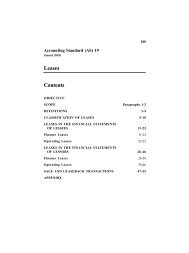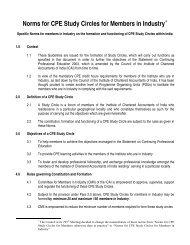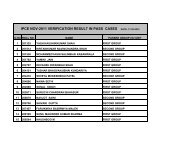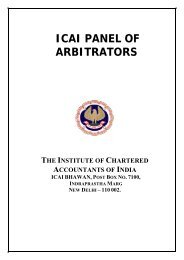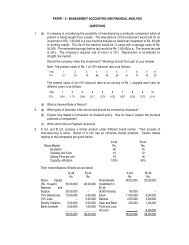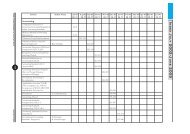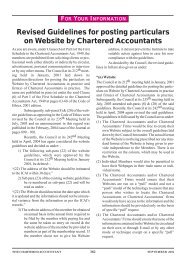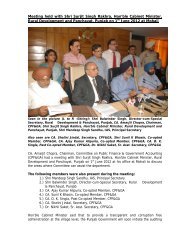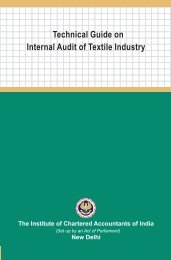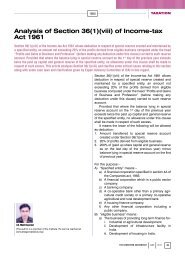The Chartered Accountant
The Chartered Accountant
The Chartered Accountant
You also want an ePaper? Increase the reach of your titles
YUMPU automatically turns print PDFs into web optimized ePapers that Google loves.
DECEMBER 2008 1110 THE CHARTERED ACCOUNTANT<br />
EXPOSURE DRAFTS<br />
EXPOSURE DRAFT<br />
Standard on Internal Audit (SIA)<br />
ENTERPRISE RISK MANAGEMENT<br />
<strong>The</strong> Internal Audit Standards Board (hitherto known as the Committee on Internal Audit), of the Institute of<br />
<strong>Chartered</strong> <strong>Accountant</strong>s of India invites comments on the Exposure Draft of the Standard on Internal Audit (SIA),<br />
Enterprise Risk Management. Comments are most helpful if they indicate the specific paragraph(s) to which they<br />
relate, contain a clear rationale and, where applicable, provide a suggestion for alternative wording.<br />
Introduction<br />
1. <strong>The</strong> purpose of this Standard on<br />
Internal Audit is to establish standards<br />
and provide guidance for review of<br />
an entity’s risk management initiatives<br />
during an internal audit or such other<br />
review exercise with the objective of<br />
providing an assurance thereon.<br />
2. Enterprise risk management enables<br />
management to effectively deal<br />
with risk, associated uncertainty and<br />
enhancing the capacity to build value<br />
to the entity or enterprise and its stakeholders.<br />
Internal auditor may review<br />
each of these activities and focus on<br />
the processes used by management to<br />
report and monitor the risks identified.<br />
Risk and Enterprise Risk<br />
Management<br />
3. Risk is an event which can prevent,<br />
hinder, fail to further or otherwise obstruct<br />
the enterprise in achieving its<br />
objectives. A business risk is the threat<br />
that an event or action will adversely<br />
affect an enterprise’s ability to maximize<br />
stakeholder value and to achieve<br />
its business objectives. Risk can cause<br />
financial disadvantage, for example,<br />
additional costs or loss of funds or<br />
assets. It can result in damage, loss of<br />
value and /or loss of an opportunity<br />
to enhance the enterprise operations<br />
or activities. Risk is the product of<br />
probability of occurrence and the financial<br />
impact of such occurrence.<br />
4. Risk may be broadly classified into<br />
Strategic, Operational, Financial and<br />
Comments should be submitted in writing to:<br />
Secretary, Internal Audit Standards Board,<br />
<strong>The</strong> Institute of <strong>Chartered</strong> <strong>Accountant</strong>s of India,<br />
ICAI Bhawan, C-1, Sector-1,<br />
Noida – 201 301<br />
<strong>The</strong> last date for receiving comments is January 12, 2009.<br />
Comments can also be emailed at cia@icai.in.<br />
Knowledge. Strategic Risks are associated<br />
with the primary long-term<br />
purpose, objectives and direction of<br />
the business. Operations Risks are associated<br />
with the on-going, day-to-day<br />
operations of the enterprise. Financial<br />
Risks are related specifically to the<br />
processes, techniques and instruments<br />
utilised to manage the finances of the<br />
enterprise, as well as those processes<br />
involved in sustaining effective financial<br />
relationships with customers and<br />
third parties. Knowledge Risks are associated<br />
with the management and<br />
protection of knowledge and information<br />
within the enterprise.<br />
Process of Enterprise Risk<br />
Management and Internal<br />
Audit<br />
5. Enterprise Risk Management is a<br />
structured, consistent and continuous<br />
process of measuring or assessing risk<br />
and developing strategies to manage<br />
risk within the risk appetite. It involves<br />
identification, assessment, mitigation,<br />
planning and implementation of Risk<br />
and developing an appropriate Risk Response<br />
policy. Management is responsible<br />
for establishing and operating the<br />
risk management framework on behalf<br />
of the board.<br />
6. <strong>The</strong> Enterprise Risk Management<br />
Process consists of Risk identification,<br />
prioritization and reporting, Risk<br />
mitigation, Risk monitoring and assurance.<br />
Internal audit is a key part of<br />
the lifecycle of risk management. <strong>The</strong><br />
corporate risk function establishes the<br />
policies and procedures, and the assur-<br />
ance phase is accomplished by internal<br />
audit.<br />
Role of the Internal Auditor<br />
in Relation to Enterprise Risk<br />
Management<br />
7. <strong>The</strong> role of the internal auditor<br />
in relation to Enterprise Risk Management<br />
is to provide assurance to<br />
management on the effectiveness of<br />
risk management. Due consideration<br />
should be taken to ensure that the<br />
internal auditor protects his independence<br />
and objectivity of the<br />
assurance provided. <strong>The</strong> role of the<br />
internal auditor is to ascertain that risks<br />
are appropriately defined and managed.<br />
8. <strong>The</strong> extent of internal audit’s role<br />
in enterprise risk management will depend<br />
on other resources, internal and<br />
external, available to the board and on<br />
the risk maturity of the organisation.<br />
<strong>The</strong> nature of internal audit’s responsibilities<br />
should be adequately<br />
documented and approved by those<br />
charged with governance. <strong>The</strong> internal<br />
auditor should not manage<br />
any of the risks on behalf of the<br />
management or take risk management<br />
decisions. <strong>The</strong> internal auditor<br />
should not assume any accountability<br />
for risk management decisions<br />
taken by the management. Internal<br />
audit has a role only in commenting and<br />
advising on risk management and assisting<br />
in the effective mitigation of risk.<br />
9. <strong>The</strong> Internal Auditor has to review<br />
the structure, effectiveness



